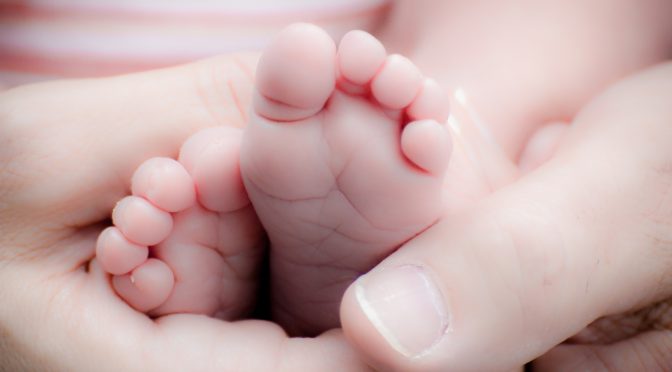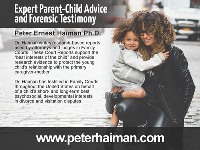Achieving world peace and harmony is not an easy, straightforward task. There are no quick fixes. There is no silver bullet. Many people consider world peace as a pipe dream. But I choose to believe that each generation moves ever closer to the goal through the individual work of professionals and activists, and of course, parents being intentional in nurturing peace as a family value in their children.
Among the peacebuilders in this collective are infant massage educators. Raising awareness of the infant development need of nurturing touch — as well as teaching parents how to respectfully respond to their baby — goes a long way in teaching families how to communicate and interact with one another and others in ways that nurture peace.
 To this end, I’d like to introduce Vimala Schneider McClure, the founder of the International Association of Infant Massage and author of the book, Infant Massage: A Handbook for Loving Parents. She developed the original techniques for infant massage, coined the term “infant massage,” and single-handedly began the international infant massage movement.
To this end, I’d like to introduce Vimala Schneider McClure, the founder of the International Association of Infant Massage and author of the book, Infant Massage: A Handbook for Loving Parents. She developed the original techniques for infant massage, coined the term “infant massage,” and single-handedly began the international infant massage movement.
Q: Thank you, Vimala, for this opportunity. Let’s begin by learning about you.
A: Very early in life, I began to practice yoga. When I was 21, I traveled to India to learn to become a yoga teacher. Being an anti-establishment “hippie,” I didn’t go to college. Much later, in the late ’80s, I went to university and studied psychology with a specialty in infant psychology.
Q: For parents new to the idea, please share about the benefits of infant massage?
A: So many! Generally, we break it down into these categories:
- Interaction — Massaging your baby promotes bonding. It contains every element of the bonding process. Infant massage promotes a secure attachment with your child over time. It promotes verbal and nonverbal communication between the two of you. Your baby receives undivided attention from you. He feels respected and loved. It is one of the only times that all of his senses are nourished.
- Stimulation — Infant massage aids in the development of your baby’s circulatory, respiratory, and gastrointestinal systems. It aids in sensory integration, helping your baby learn how her body feels and what its limits are. Massaging your baby helps make connections between neurons in the brain, which helps develop her nervous system. It also aids the generation of muscular development and tone, and contributes to her mind-body awareness.
- Relaxation — Regular infant massage improves sleep, increases flexibility, and regulates behavioral states. It reduces stress and stress hormones and hypersensitivity. Massaging your baby creates higher levels of anti-stress hormones and promotes an improved ability to self-calm. Because we use a kind of “conditioned response” called touch relaxation, it teaches your infant to relax in the face of stress and upon the voice and touch of parents.
- Relief –Infant massage helps with gas and colic, constipation and elimination, muscular tension, and teething discomfort. It also helps with “growing pains,” organizes the nervous system, relieves physical and psychological tension, and softens skin. It helps release physical and emotional tension, balances oxygen levels, and provides a sense of security.
- Benefits for the Family — Infant massage encourages the involvement of siblings and extended family in baby care. It promotes a relaxed environment in the home, communication, and respect.
- Benefits for Society — Imagine a world where people are trained to be good parents…where newborns, older babies, toddlers, and children were routinely given healthy, loving massages every day…where the entire culture valued positive, nurturing touch, respect, and empathy. There would be reduced infant health care costs, reduced child abuse, reduced behavioral problems in children, and reduced violence. When I founded the International Association of Infant Massage, this is what I imagined: changing the world, one baby at a time.
Q: You mention how infant massage promotes secure attachment Can you expound on how infant massage fits into API’s Eight Principles of Parenting?
A: Beautifully! When I discovered API, I was thrilled. At last there was an organization teaching the same basic things we do. However, it was long past my days as a mother of little ones, and I was so busy with IAIM that I couldn’t get training as an API Leader. If it was there in 1976, I would have been there!
- Preparation — We believe in education and preparation for parents. Though we don’t teach prenatal classes, we advocate as much as we can for parents to know and understand the growth and development of their unborn babies, and that massage can begin prenatally.
- Feed with Love and Respect — Though we don’t teach anything about feeding in particular, we advocate respect as an important element in a parent’s relationship with their baby. Before the massage begins, parents observe the baby’s cues, and then give a cue that massage might be happening. We teach parents to swish the massage oil between hands, then hold hands up to baby, saying, “May I massage your legs, feet, tummy, etcera,” and observe the baby’s cues. The first time, it often seems kind of silly to parents. But after that, babies understand quickly, and through their body language, give — or not –their permission.
- Respond with Sensitivity — Building trust and empathy from the start is very important. Learning their baby’s cues and newborn reflexes helps parents understand their babies and respond appropriately.
- Use Nurturing Touch — This is what infant massage is all about. Physical contact, affection, security, stimulation, movement, all of the elements of bonding, which include eye contact, skin-to-skin contact, the soothing sound of a parent’s voice, rhythm, odor, play, are all included in the massage. I advocate carrying as much as possible and cosleeping.
- Ensure Safe Sleep, Physically and Emotionally — While we usually do not cover sleep in our classes unless asked by parents individually, I advocate cosleeping. I spend a lot of time researching these things for IAIM. Since my time in India, years before having a family, I planned for us to have a family bed.
- Provide Consistent and Loving Care — We emphasize bonding and attachment, and encourage parents to massage their babies every day consistently.
- Practice Positive Discipline — Massaging their baby leads to the development of conscience and other important brain functions. Including respect in the massage routine strengthens attachment and shows parents the results of that consistent, loving, and responsive way of being.
- Strive for Balance in Your Personal and Family Life — We encourage parents to massage their babies every day. Thus, they develop confidence in their parenting choices and are more likely to keep balance in their family life. We encourage fathers to learn the massage. Infant massage includes fun and play, and parents can take a sigh of relief when they have provided this beautiful, intimate time for their little ones every day. Most often, massage becomes a part of family life, with new siblings learning to help massage their little brother or sister, and receiving a different sort of massage as they grow older.
Q: How do you see infant massage tied into promoting world harmony?
A: Children learn how to be, from their parents modeling that behavior. Infant massage naturally makes for kind parents and children. The daily interaction of loving, nurturing touch affects everybody deeply.
These days, we talk a lot about infant mental health, and the things that go into making sure our children are thoughtful, nurturing, empathic, kind people. Parents tell me about their children who are all grown up and are amazing, thoughtful, intelligent, compassionate people. I can see it in my own kids, now parents themselves, and even in my grandchildren.
There is a kind of automatic generation of warmth, empathy, and kindness in the family, just from doing this seemingly simple practice when the children are babies — and beyond.
Q: So, how did you originally become inspired in infant massage?
A: When I traveled to India, in 1973, I attended a training center for yoga teachers. I worked in an orphanage during the day, and a monk would come at night to teach us. I noticed all the children in and out of the orphanage were friendly, relaxed, inclusive, and responsible. They were always smiling and laughing, and I often saw a small child walking around with a baby on his hip.
One night, after class, I was walking around the inner compound of the orphanage. Through the doorway where the children slept, I heard someone singing. I peeked in, and saw a 12-year-old girl massaging a baby. Intrigued, I went to observe, and I asked her about it — I knew some Bengali, her language. She said it was customary for babies to be massaged every day. She taught me how, and I began to think that perhaps the children were so friendly, relaxed, because they had been massaged like this when they were babies.
It made a great impression on me, and after I returned home, by coincidence, I was given a copy of the late Ashley Montagu’s book Touching: the Human Significance of the Skin.
Q: When and how did the infant massage movement begin?
A: In 1976, I was pregnant with my first baby. I thought, again, about my time in India. I pulled out Montagu’s book and read it cover-to-cover. I saw the amazing research on animals about how nurturing touch completely changed them. I began to be very excited about the prospect of massaging my baby. I started going to the medical library and looking up all of the references in Montagu’s book, copying them and making notes.
I started massaging my baby right after he was born. I used the massage routine I had learned in India. He was colicky and cried all the time. When I started to massage his stomach, he would get fussy. Most people would think, “My baby doesn’t like being massaged.” But something told me to continue.
Using what I knew from India, from yoga, from my friends who were massage therapists and reflexologists, plus my observations of my own baby, I put together a massage routine that was very different from the Indian one. I included Indian strokes, which go from the center outward to release tension, Swedish strokes which go from the extremities to the heart to promote circulation, and yoga movements and massage that help the digestive system and aid in flexibility. I developed a special routine for colic, which resolved my baby’s colic in 2 weeks.
After several months, I decided to share what I knew with other parents and wrote a curriculum for a 5-session course. I designed a small flyer and took it around to stores, asking them to post it on their window and have them available at the check-out counter. My first class was in March 1977 with 5 moms and their babies in my living room.
I continued to teach out of my home, and my classes became larger and larger. Babies of every dimension and age were brought to my classes — newborns, older babies, premature babies, and some with developmental issues. I continued to read and research. I learned so much during that time!
In 1978, I decided to try to make a booklet about infant massage — actually, I was the first person to call it that (infant massage) — for people who came to my classes. I began to get invited to speak at conferences for childbirth educators. At my first talk for Lamaze, after I finished, a man from the audience came to me and asked me if I had thought of writing a book. I told him, yes, and I happened to have a manuscript in my bag. He said he was from Bantam Books in New York, and they had been looking for me. The following week, I received a contract from them, and my book, Infant Massage: A Handbook for Loving Parents, was published.
In 1979, I began to get requests from childbirth educators to teach them how to be infant massage instructors like me. Knowing that no such thing existed, I decided to design a curriculum and certification for instructors, and the International Association of Infant Massage (IAIM) was born.
In 1982, Bantam sent me on a book tour throughout the United States, and my book really took off. I trained my first large group of instructors and had 501(c)3 nonprofit papers made up for the association. During that time, I began training some instructors to be trainers of instructors — I designed a 4-day training program for them. I wrote A Manual for Infant Massage Instructors, which was published by the organization.
In 1986, we had instructors from other countries, and we moved the headquarters to Sweden.
Q: What a legacy! Did you encounter any challenges?
A: In spite of having severe difficulties with my health, the trainers I had trained and several Certified Infant Massage Instructors, were determined to carry out my vision. The trainers kept teaching trainings, and some experienced trainers took what I had developed to train them and began certifying other trainers. IAIM began having conferences, first in the U.S., then all over the world.
I never went to the medical establishment for recognition or support. I had seen other organizations that were basically swallowed up by all the “rules” of medicine. I had an intuition about this and was very firm about it. Eventually, IAIM became so big and respected worldwide, and medical professionals began coming to us. Now we have quite a number of therapists, nurses, even MDs working with us.
Instructors and trainers got together all over the world and began forming chapters in their countries. Now, we have a circle of trainers of over 50 people, and IAIM is in over 70 countries. My book was eventually published in 14 other languages, and our training materials updated through the years with my oversight and approval. We have a trainers’ meeting, educational conference, and general assembly every other year somewhere in the world.
I am happy to say that I am very healthy and happy and able to work now.
Q: I’m glad your health has been restored. Where do you see your organization going from here?
A: IAIM will continue to grow and be recognized as a leader in nurturing touch for babies and families. Now we have people in IAIM who have the credentials to carry out research for us. We have a specially developed NICU [Neonatal Intensive Care Unit] procedure, which is well accepted and with which we want to do some research.
I was very excited to have the opportunity to write a whole new updated, revised edition of Infant Massage: a Handbook for Loving Parents, released in February 2017 by Random House. It will introduce whole new generations of parents to infant massage.
Interview by Rita Brhel, Attachment Parenting International (API)

